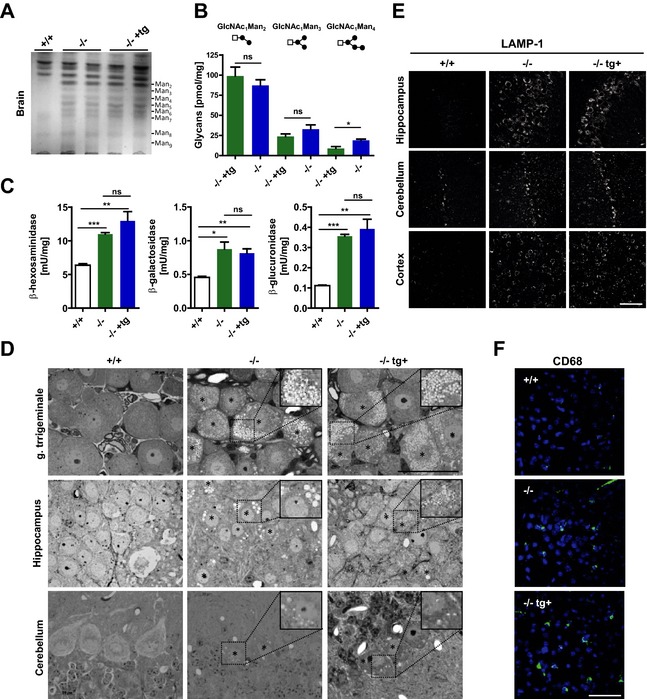Figure 2.

Immune‐tolerant transgenic alpha‐mannosidosis mice are phenotypically indistinguishable from nontransgenic animals. (A) Separation of neutral oligosaccharides extracted from brains of 3‐4 months old wild‐type (+/+), nontransgenic (‐/‐) and transgenic (‐/‐ +tg) mice by TLC shows comparable amounts of all glycan species (Man2–Man9). (B) Quantitative analysis of oligosaccharides by high pressure liquid chromatography indicate equal levels of the major glycan species Man2 and Man3 (n = 3‐4, per genotype). (C) α‐glucuronidase, β‐hexosaminidase and α‐galactosidase show a similar increase in their specific activity in brain extracts of nontransgenic and transgenic knockout mice compared to wild‐type animals (n = 3, per genotype). (D) Light microscopy of Toluidine‐stained semithin sections from the ganglion (G.) trigeminale, hippocampus and cerebellum reveals similar amount of storage vacuoles in both knockout strains. Scale bar: 50 μm, insets show zoomed images of the outlined area; stars (*) highlight vacuolated storage cells. (E) Immunofluorescence labeling of LAMP‐1 revealed a similar increase in LAMP‐1 levels in ‐/‐ and ‐/‐ tg+ mice compared to +/+ animals in the hippocampus, cerebellum and the cerebral cortex (Scale bar: 50 μm). (F) Reactive microglia (green) are present to a similar degree in the molecular layer of the cerebellum of ‐/‐ and ‐/‐ tg+ mice (4’,6‐Diamidin‐2‐phenylindol (DAPI), blue; Scale bar: 50 μm) (*P < 0.05, **P < 0.01, ***P < 0.001). TLC, thin layer chromatography; LAMP‐1, Lysosome‐associated membrane glycoprotein 1.
